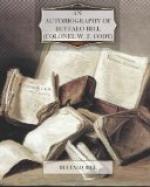In my dealings with the Indians we always understood each other. In a fight we did our best to kill each other. In times of peace we were friends. I could always do more with the Indians than most white men, and I think my success in getting so many of them to travel with my organization was because I understood them and they understood me.
Shrewd as were the generals who conducted the fight against the Indians, I believe they could have done little without the services of the men who all over the West served them in the capacity of scouts.
The adventures of small scouting parties were at times even more thrilling than the battles between the Indians and the troops.
Among the ablest of the scouts I worked with in the West were Frank Grouard and Baptiste Pourier. At one time in his childhood Grouard was to all intents and purposes a Sioux Indian. He lived with the tribe, hunted and fought with them, and wore the breech-clout as his only summer garment.
He met some hunters and trappers while living this life. Their language recalled his childhood, and he presently deserted his red-skinned friends and came back to his own race.
His knowledge of the tongues of the Sioux, Cheyenne, and Crow Indians and his marvelous proficiency in the universal sign language made him an extremely desirable acquisition to the service.
Grouard and “Big Bat” (Baptiste Pourier) were the two scouts that guided Lieutenant Sibley, a young officer of experience and ability, on a scout with about thirty officers and John Finnerty of the Chicago Times, a newspaper man who was known all over the West.
At eight o’clock at night they left their halting-place, Big Goose Creek, and in the silent moonlight made a phantom promenade toward the Little Big Horn.
Presently they made out the presence of a war party ahead of them, and one of the scouts of this outfit began riding around in a circle, which meant that the enemy had been discovered.
There were too many Indians to fight in the open, so Grouard led the soldiers to a deep thicket where there were plenty of logs and fallen timber out of which to make breastworks.
The Indians repeatedly circled around them and often charged, but the white men, facing a massacre like that of Custer’s men, steadily held them at bay by accurate shooting.
Soon red reenforcements began to arrive. The Indians, feeling that they had now a sufficient advantage, attempted another charge, as the result of which they lost White Antelope, one of the bravest of their chiefs.
This dampened their ardor, but they kept up an incessant firing that rattled against the log breastworks like hailstones.
Fearing that the Indians would soon start a fire and burn them out, Sibley ordered a retreat. The two scouts were left behind to keep up a desultory fire after night had fallen, in order to make the Indians think the party was still in its breastworks. Then the other men in single file struggled up the precipitous sides of the mountain above them, marching, stumbling, climbing, and falling according to the character of the ground they passed over.




